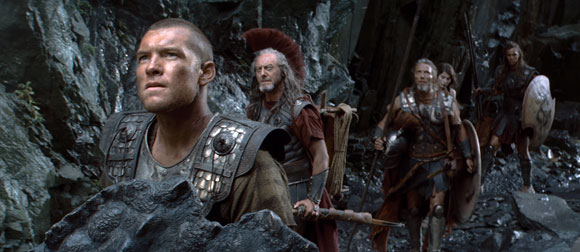Clash of the Titans

One sign that the medium has plateaued is that, 95 years after the birth of the modern motion picture, Hollywood has completely run out of new ideas. In 2005, a cursory glance at the production schedule for 2006 showed that third of one major studios’ films in production were remakes, reboots or sequels. Now, it’s worse.
That said, Louis Leterrier’s take on Desmond Davis’ B-movie classic is in some respects an improvement. Much of the particulars are the same. Perseus, son of Zeus, finds himself compelled to fight for the city of Argos, upon which the Olympians have unleashed the Kraken to smite King Acrisius—disfigured by Zeus for his transgressions against the gods.
The original screenplay, by Beverley Cross, had a more developed story. Here, we learn little about the bickering, pernicious gods’ dramas or their causes. The original featured a stellar cast, including Laurence Olivier as Zeus, Ursula Andress as Aphrodite and Maggie Smith as Thetis (tacked on because she was married to Mr. Cross at the time).
The new film seems primarily motivated by the advent of CGI. The original featured the work of stop-motion pioneer Ray Harryhausen. Before watching the 1981 B-movie classic this week for reference, I recalled the effects were laughably terrible. The film had been on the shelf since shooting wrapped in 1979, which served to date it further as Fox’s groundbreaking visual-effects feast, Star Wars, and Robert Wise’s Star Trek: The Motion Picture were released in the interim. Note that Mr. Wise was Orson Welles’ editor on Citizen Kane. Thus, a turning point was reached, as the corporate conglomerates were reaching maturity and the narratively-bankrupt visual-effects blockbuster was born.
Clash of the Titans, in this iteration, introduces us to Sam Worthington as Perseus embarking upon Joseph Campbell’s “Hero’s Journey.” He is guided by Io (Gemma Arterton), a priestess of Hera in Argos, the city threatened with devastation by the Kraken. As the demigod son of Zeus (Liam Neeson) and Acrisius’ wife Danaë (Tine Stapelfeldt), he’s left unharmed as his loving, adoptive parents drown—victims of Hades’ (Ralph Fiennes) revenge against nearby soldiers of the King of Argos, seen demolishing a statue of the father of the gods. Years later, still angry at the gods, he joins forces with Argos to defend against a vindictive pantheon.
The writers, all three of them, reorganized details—some better and some worse. In the original movie, and the mythology, King Acrisius’ wrath made more sense as Danaë was his daughter. Here, he’s irrationally angry at her for sleeping with Zeus, divinely masked to look like him. But never mind.
The film is edited at a much quicker pace than its theatrical predecessor. The colossal Kraken—less like an amphibious Godzilla suit than a mutated, behemoth sea turtle—is introduced far later in the film, effecting greater dramatic buildup. The trailers have already shown us all the good bits including an armor-clad woolly mammoth resembling Liam Neeson shot with a smudged lens, bellowing, “Release the Kraken!”
Some of the changes add a darker tone to this film. The lord of the underworld, Hades is a balding, wheezing schemer—must be chronic emphysema from all the fire and brimstone. His entrances remind me of X-Men’s teleporting Nightcrawler, moving like smoke, materializing instantly. Perseus and his band of warriors also encounter a strange race of ancient beings, the Djinn, led by Sheikh Suleiman (Ian Whyte) whose face resembles petrified bark. Aside from some cartoonish growls, he is accompanied by music unusually ominous in relation to the rest of Ramin Djawadi’s otherwise bland score. Also, they happen to know how to tame giant scorpions that, as far as I can tell, had just now spawned from the blood of the deformed Calibos (Acrisius).
Despite its pacing, the film still feels slow for most of its 118-minute duration—feeling more like three hours than two. This may owe to the film’s emphasis on filler than character development to stay the climactic confrontation with the Kraken. Nowhere in its two hours will you find a hoplite uttering lines as (hilariously) evocative as, “These accursed hell-sent swarms of blood-gutted marshflies,” or delivering them with gravitas. At the same time, it’s not boring. Not particularly intelligent or deep, the film serves well as entertainment—comic interludes handily supplied by their weary captain, Solon (Liam Cunnigham). As adventure, the film is reminiscent of John Milius’ second-rate epic, Conan the Barbarian, Raiders of the Lost Ark, and the Mummy remakes starring Brendan Fraser. In that regard, the filmmakers achieved something I wasn’t expecting. They improved the visual effects without taking the silly action-oriented story too seriously. Wolfgang Petersen could have learned a thing or two from Mr. Leterrier.
 Clash of the Titans • Dolby® Digital surround sound in select theatres • Aspect Ratio: 2.39:1 • Running Time: 101 minutes • Distributed by IFC Films
Clash of the Titans • Dolby® Digital surround sound in select theatres • Aspect Ratio: 2.39:1 • Running Time: 101 minutes • Distributed by IFC Films